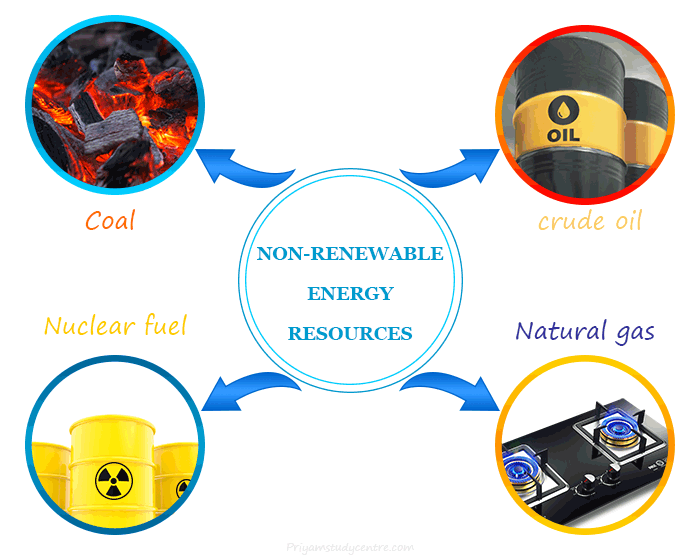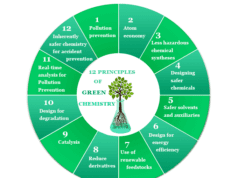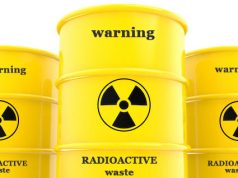Non Renewable Energy Resources
Non-renewable energy resources also called finite energy resources are natural resources that cannot be readily replaced by any natural processes after their consumption. Fossil fuels such as coal, crude oil, natural gas, and uranium are the main resources of non-renewable energy. Unlike non-renewable energy, renewable energy sources such as hydropower, wind energy, geothermal heat, and solar energy are practically infinite and can be replenished. The bulk of human society uses non-renewable energy resources to fulfill their daily demand. Fossil fuels still dominate globally and about 89 percent of daily used energy used by the United States comes from fossil fuels and nuclear power. We need to carefully consume such resources to ensure long-term usage for the upcoming generations.

Alternatives to Non-Renewable Resources
Approximately 80 percent of the total amount of energy used in our modern society each year comes from fossil fuels. We depend on non-renewable fossil fuels such as coal, crude oil, and natural gas because they are energy-rich resources and relatively cheap to process.
But major problems with such resources are that they are limited to supply and they cause environmental pollution such as air pollution. All of these resources release carbon dioxide into our atmosphere. It is the main course of the greenhouse effect and global warming.
Therefore, we see alternative sources such as wind energy and solar energy to fulfill the energy demand of our modern society. Both of these sources are clean sources of energy and an unlimited supply but the installation cost of such renewable sources is very high.
Types of Non-Renewable Resources
The most important non-renewable types of energy resources are fossil fuels such as petroleum and crude oil, coal, and natural gas. Nuclear fuel is also a part of non-renewable source of energy that is used mostly for the production of electricity.
Non-Renewable Fossil Fuels
Fossil fuel is a hydrocarbon-reached material formed naturally in the Earth’s crust from the remains of dead plants and animals. The majority of fossil fuel deposits were formed during the Carboniferous Period, around 300 to 360 million years ago. The main types of fossil fuels are coal, oil, and natural gas.
The energy obtained from fossil fuels originally came from the sun through the process of photosynthesis. In photosynthesis, solar energy is stored in plant tissues. When animals consume these plants, they add this energy to their own bodies.
Fossil fuels were formed from these dead plants and animals over millions of years. Pressure and heat worked together to transform these plant and animal remains into crude oil or petroleum, coal, and natural gas. When fossil fuels are burned, the trapped energy of sunlight is released.
Fossil fuels are a harmful part of our environment because they release carbon dioxide into the atmosphere when burning. It ultimately disrupts the balance of carbon in the earth’s atmosphere and causes the greenhouse effect and global warming.
Crude Oil
Crude oil is a mixture of hydrocarbons that exists in the liquid phase in natural underground reservoirs and is refined to form gasoline, diesel, petrol, and other petroleum products. It is used mostly to produce gasoline, diesel, and petrol fuel for vehicles. Non-renewable petroleum products are used for manufacturing a vast variety of materials essential for modern life.
Natural Gas
Natural gas is another non-renewable energy source that is used widely for cooking and heating homes. It contains mostly methane and other hydrocarbons that are pumped out through the same wells used for extracting crude oil.
Coal
Coal is a solid non-renewable fossil fuel that is used for heating homes and generating electrical energy. It is the most used form of a non-renewable resource that is primarily used as a fuel and causes the industrial revolution around the global world.
Coal mostly contains carbon and several other elements such as hydrogen, sulfur, oxygen, and nitrogen. It cannot be extracted in the same way as crude oil or natural gas may be extracted. Coal can be dug up from the coal mine.
Nuclear Fuel
Nuclear fuel is material that is used in nuclear power stations to sustain a nuclear fission reaction. Heat is created when nuclear fuel undergoes a fission reaction. The produced heat is converted to electricity in power turbines.
Uranium is the most commonly used fuel in nuclear power plants for nuclear fission. Uranium is about 100 times more common than silver but the isotope U-235 is relatively rare on our earth. It may be separated from uranium ore at uranium mills or from a slurry at the in-situ leaching method.
Nuclear fuel is not renewable, it is sustainable because it cannot be readily replaced by any natural processes after their consumption. Uranium is present in the ground at relatively low concentrations and mined in approximately 19 countries.
Unlike fossil fuels, using nuclear fuels to produce energy does not directly produce pollutants such as carbon dioxide or sulfur dioxide but it causes pollution during mining, transporting, and refining.
What is Renewable Energy?
Renewable energy is energy derived from natural sources and replaced at a higher rate than they are consumed. Sunlight and wind are the most common renewable energy resources that are used by many countries to fulfill a part of energy requirements. Other renewable energy resources have come from wave, biomass, and geothermal heat.
Unlike non-renewable counterparts, renewable resources such as the movement of water (hydropower, tidal power, and wave power), wind and radiant energy from geothermal heat and solar energy are practically infinite and cannot be depleted over time.
Renewable and Non-Renewable Sources of Energy
Renewable and nonrenewable resources are energy sources that are used by humans to fulfill their daily energy requirements.

The main difference between these two types of energy resources is that renewable resources can naturally replenish but nonrenewable resources cannot be readily replaced after their consumption. Therefore, nonrenewable resources are limited in supply and cannot be used sustainably.
Renewable Vs Non-Renewable Energy
The main differences between renewable and non-renewable energy resources are listed below in the table,
| Renewable energy | Non-renewable energy |
| Renewable energy resources cannot be depleted over time. | Non-renewable energy resources deplete over time. |
| Solar, wind, hydroelectric power, and geothermal energy are the main examples of renewable resources. | Crude oil, coal, natural gas, and nuclear fuel are examples of non-renewable resources of energy. |
| Renewable energy resources do not cause any carbon emissions and low carbon footprint. | Non-renewable energy resources have a comparatively higher carbon footprint and emissions. |
| The installation cost of renewable energy is very high. | Non-renewable resources have a comparatively lower upfront cost. |
| Installation for harvesting renewable energy is prohibitively expensive and not easily accessible in most countries. | Cost-effective and accessible infrastructure is available in most countries. |
| A large land/ offshore area is required for the installation of wind and solar farms. | Comparatively lower area required for consuming such resources. |
Advantages and Disadvantages
Most of the total amount of energy used in our modern society each year comes from non-renewable resources. Our dependence on the consumption of non-renewable energy resources is increasing day by day. It caused a rapid decline in supplies and led to climate change.
We need to know about the advantages and disadvantages of such energy resources. An overview of the advantages and disadvantages of non-renewable energy is mentioned below:
Advantages of Non-Renewable Energy
The most common advantages to use non-renewable energy resources may include:
- The main advantages of non-renewable resources such as crude oil, coal, natural gas, and nuclear fuel are affordable to use and easy to transport.
- It may be efficiently converted to other types of energy that are required for our modern society.
- These resources are cost-effective and easier to produce and use.
- It is easily accessible and consumers can find non-renewable resources at a very affordable price.
- It provides a high energy density compared to renewable energy resources.
- Huge profits may be gained when selling non-renewable resources such as coal, oil, and natural gas.
- Most of the non-renewable sources are quite easy to store and use whether in a home or anywhere else.
- Non-renewable resources may create jobs during extracting, transporting, and refining.
Disadvantages of Non-Renewable Energy
The most common disadvantages to using such energy resources may include:
- One of the major disadvantages of non-renewable energy is that it is a time-consuming and affordable process. For example, mining coal, searching for oil, installing and building oil drills, and inserting pipes to extract and transport natural gases are very time-consuming and affordable processes.
- Non-renewable energy resources cannot be readily replaced after their consumption. Therefore, we need to carefully consume such resources to ensure long-term usage for the upcoming generations.
- Non-renewable sources may be dangerous for human health and the environment because sources like fossil fuels emit greenhouse gases such as carbon dioxide and sulfur dioxide.
- Fossil fuels such as coal, oil, and natural gas release a large amount of carbon dioxide when burning. Therefore, it rapidly destroys the ozone layer that protects us from UV radiation.
- Sulfur dioxide released from non-renewable energy resources converts rain into acid rain. It is harmful to wildlife and human beings.
- A number of health risks arise in the workers who work in coal mines or oil drills because it causes a large number of diseases, injuries, and even deaths.
- Every time we need to keep a huge amount of fuel in reserve for working power station. Therefore, it can be expensive and require a lot of space.
- Non-renewable energy resources are risky to transport because sometimes oil tankers crash and spill the contents into the sea or elsewhere which may have deadly effects on sea animals and human beings.







